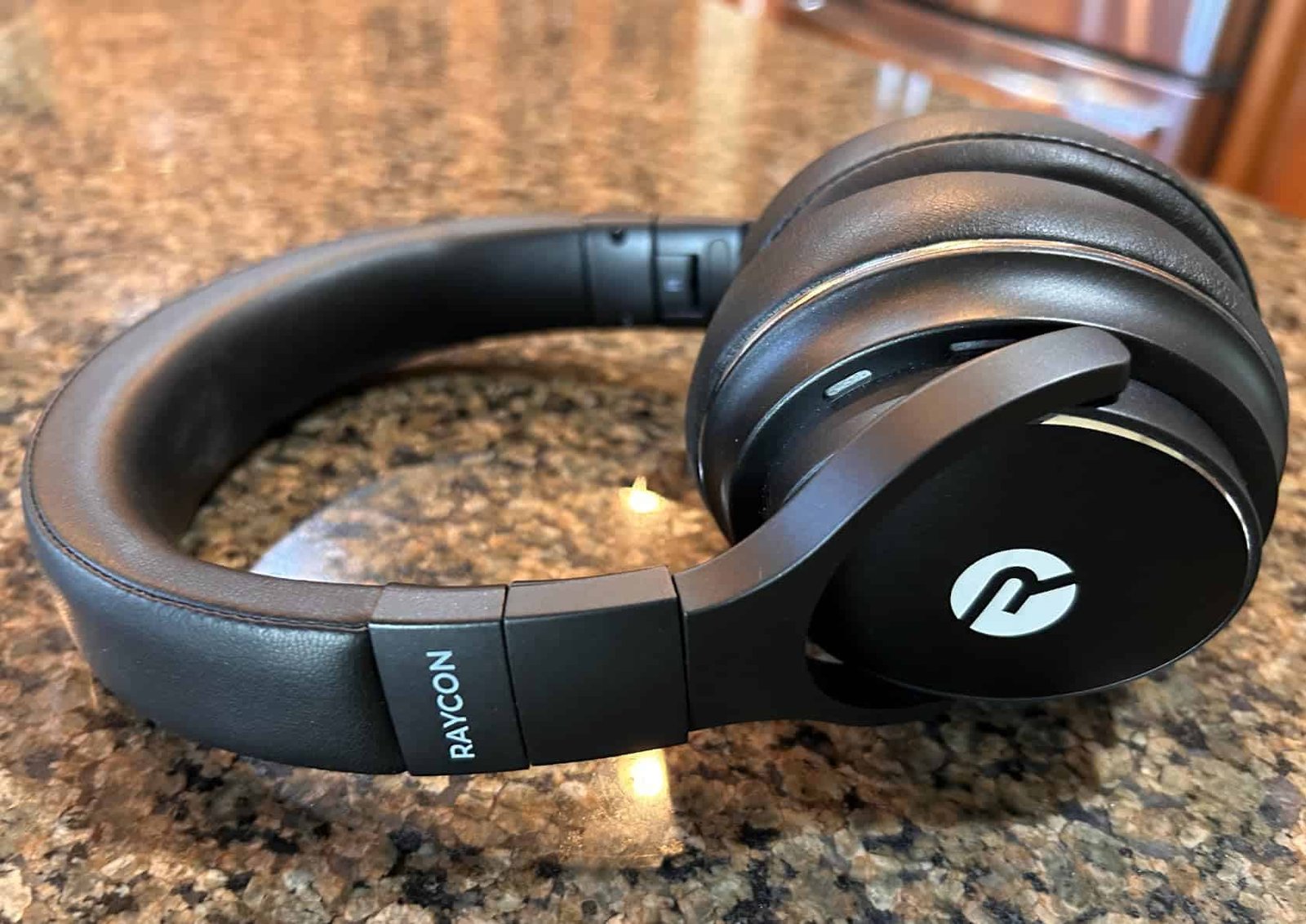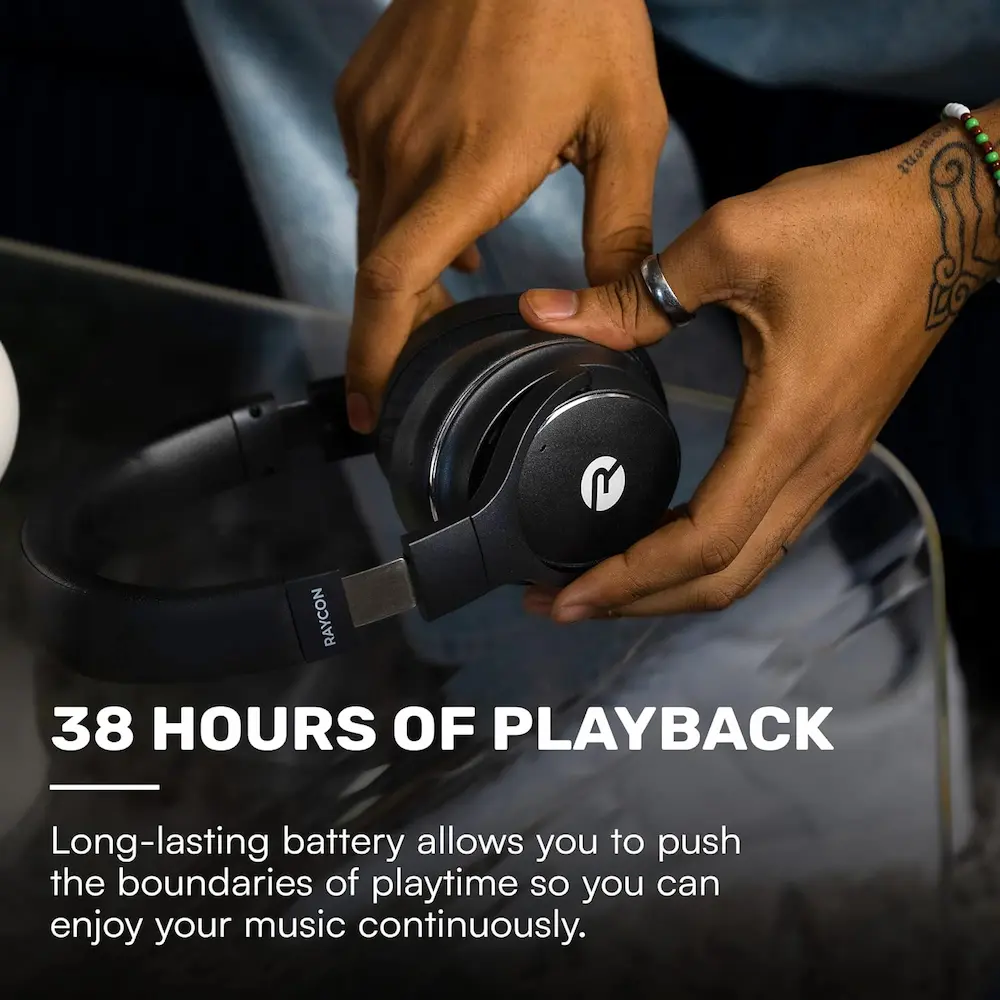I’ve spent the last week living with the Raycon “The Everyday” Headphones as part of my regular review cycle. That means using them through daily writing sprints, voice calls, travel commutes, and a few long nights with ambient music in the background.
Table of Contents
I took notes on every strength and every frustration. In the sections below, I’ll walk you through the entire experience from the unboxing to whether I think they’re worth your money.
Unboxing and First Impressions
Design and Build Quality
Raycon’s minimal matte-black sleeve slides away to reveal a hardboard box that opens with a reassuring magnetic snap budget price, boutique vibe. Inside, the headphones rest folded flat in a molded cradle, flanked by a short USB-C cable, a 3.5 mm AUX lead, and a postcard-size quick-start. There’s no hard case; instead, Raycon includes a soft drawstring pouch better than nothing, though it won’t stop crushing in a stuffed backpack.

In hand, the plastic feels light yet not toy-like. A low-sheen finish resists fingerprints, and subtle gloss rings around each cup break up the all-black monotony without shouting. The yokes rotate 90° for a flat fold, and the headband extends on numbered metal rails handy for returning to a favorite notch. Still, flex the frame and a faint creak reminds you this is plastic without interior metal reinforcement. Raycon did manage an IPX4 rating, so sweat and light drizzle won’t void the warranty, but I wouldn’t trust them to survive a drop on concrete more than once.
Comfort Over Marathon Sessions
Initial clamping force is moderate, but shallower pads and a wide headband translate to a looser feel on small-to-medium heads. At its smallest extension the arch still floats 3–4 mm above my crown; I could tilt forward and feel the cups slip slightly.

During short calls that isn’t an issue, yet after three-hour editing blocks I found myself nudging them back into position every 20 minutes. Heat buildup remained low thanks to perforated synthetic leather, and at 280 g, weight fatigue never arrived still, a deeper cushion and tighter seal would have made them truly “forget-they’re-on” comfy.
Controls and Everyday Handling
All controls cluster on the right cup: a textured power/pairing button, volume rocker, and a multifunction key for play/pause and skip. A dedicated ANC/Awareness toggle rounds out the set. Button feel is crisp, with raised edges easy to identify blind.

Spins to the gym revealed another plus: the ANC button sits between two low ridges, so you’re not likely to trigger it accidentally mid-rep. Startup and shutdown always come with a cheery “Raycon” voice prompt cute the first few times, mildly grating by day five, and unfortunately un-mutable.
Connectivity, Range, and Latency
Pairing to my Pixel 8 and M2 MacBook took seconds via Bluetooth 5.0. The headphones remember up to eight devices, but multipoint isn’t supported; you’ll need to disconnect before pairing a second source. Range impressed: I walked 11 meters and through two walls before a brief stutter, outperforming older SBC-only sets.
Codec support tops at SBC and AAC no aptX or LDAC but video remained lip-synced on Netflix and YouTube, and rhythm games like Beatstar were playable without audio lag yes noticeable.
Battery Life in Real Use
Raycon advertises 38 hours of playback sans ANC and roughly 32 with it active. I split the week 60/40 in favor of ANC-on, averaging six hours daily at 65 % volume.

The low-battery chime landed midday Friday just over 31 hours logged, close to rated claims. A 15-minute quick charge via USB-C netted me two hours of music, useful for morning commutes. A full cycle from flat to 100 % took about 1 hour 50, right on spec.
Sound-Test Method
For consistency I calibrated the output to ~75 dB SPL using pink noise and a MiniDSP EARS rig. Sources included FLAC via Foobar2000 on a PC interface, Spotify Premium at 320 kbps on Android, and Tidal Hi-Fi on Mac. Test genres ranged from atmospheric (Max Richter) to bass-heavy (Run the Jewels), plus voice-centric podcasts and Zoom calls. I cross-checked against my daily drivers: Skullcandy Hesh ANC, Sony WH-CH720N, and Audio-Technica ATH-M40x (wired through an iFi hip-DAC).
Audio Performance – Wireless Mode
Raycon aims squarely for mainstream appeal: a pronounced V-shape with substantial low-end lift and smoothed treble. Sub-bass extends to around 40 Hz, giving hip-hop and EDM real thump Billie Eilish’s “Oxytocin” hit with satisfying rumble. But that boost spills into mid-bass, occasionally masking guitars and male vocals.
The 5 kHz region dips, warming the mix but hiding presence details; treble rebounds near 9 kHz, adding sparkle without sibilance. Result? A fun, fatigue-free tone that flat-response purists will find veiled. Stereo width feels modest, with instruments clustering center-stage, yet layering is clear enough to separate kick, snare, and bass synth.
Audio Performance – Wired Mode
Plugging the included 3.5 mm cable (battery still required) tightens bass by 2 dB and lifts upper mids, restoring vocal clarity. Acoustic tracks like Fleetwood Mac’s “Dreams” gain string texture lost in wireless.

Treble also opens up, though overall character remains warm. Resolved detail still lags behind reference monitors, yet for casual mixing checks it’s acceptable. Wired mode also eliminates Bluetooth compression artifacts in cymbal tails and micro-detail worth using if your source has a decent DAC.
Microphone Quality and Chat
Raycon touts “five high-clarity microphones.” In practice, call partners heard my voice natural and free from fan noise, though room echo slipped in. Wind rejection struggled outdoors; gusts created low-frequency rumbles the digital filter couldn’t remove. For remote meetings or Discord the mic suffices, but podcasting or streaming will demand an external solution.
Gaming Experience
Jumping into Valorant revealed a narrow soundstage: left/right cues accurate, depth less so. Footsteps were audible, but pinpointing elevation proved tricky. ANC introduced negligible latency; still, SBC/AAC limits competitive edge vs. dedicated low-latency headsets.
Bass-heavy explosions in Apex Legends felt immersive, yet the boosted low end occasionally masked reload clicks. Comfort issues resurfaced: rapid head turns loosened the fit, forcing readjustment mid-round. For casual console gaming they’re fine; sweaty ranked sessions, maybe not.
Music and Movies
These headphones shine with modern pop, hip-hop, and action films. Big bass gives Marvel soundtracks cinematic heft, while dialogue stays intelligible. Plug in awareness mode on a commute and exterior ambience blends with playlists but honestly, ANC never truly isolates, so awareness felt redundant. For jazz and classical, recessed mids dull piano timbre and string texture. Movie night viewers will enjoy the warm tilt; audiophiles hunting micro-detail likely won’t.
Final Verdict
Raycon The Everyday Headphones tick undeniable lifestyle boxes: slick unboxing, fast pairing, strong battery, and fun bass-forward sound. Build is solid for plastic, and IPX4 sets them apart in the budget ANC crowd. Yet comfort quirks shallow pads and loose fit plus average ANC and veiled mids prevent them from challenging class leaders. If you prioritize punchy tunes, long battery, and stylish minimalism under $100, they’re a respectable pick. If you need studio clarity, clamp security, or app-level EQ control, keep shopping.
The Raycon The Everyday is available on Amazon.
Pros and Cons
Pros
- 38-hour battery life with quick-charge top-ups
- Bass-rich, energetic tuning ideal for pop/hip-hop
- USB-C charging, fold-flat design, IPX4 splash protection
- Clear enough mic for everyday calls
- Fast, reliable Bluetooth pairing and solid range
Cons
- Loose headband on smaller heads; shallow pads reduce seal
- ANC merely average; Awareness Mode feels redundant
- Midrange detail recessed; limited codec support (no aptX)
- Requires battery even in wired mode
- No companion app or EQ presets